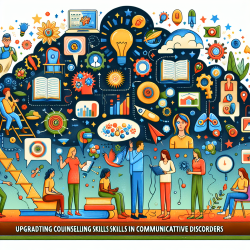As a practitioner in the field of communicative disorders, continuous improvement and skill enhancement are vital for providing the best possible care to your clients. The research article "Counseling in Communicative Disorders" by Seppo K. Tuomi offers valuable insights and practical guidelines that can significantly enhance your counseling techniques.
This book, although not a comprehensive textbook, serves as a crucial resource for handling the psychological-emotional problems associated with various communicative disorders. Let's delve into some key takeaways and how you can implement them to elevate your practice.
1. General Interviewing and Counseling Techniques
The first chapter of the book provides general guidelines on various interviewing and counseling techniques. These foundational skills are essential for building rapport and trust with your clients. Consider incorporating the following strategies:
- Active Listening: Show empathy and understanding by actively listening to your clients. This involves not just hearing their words but also understanding their emotions and concerns.
- Open-Ended Questions: Encourage clients to express themselves more freely by asking open-ended questions. This can provide deeper insights into their issues and needs.
- Reflective Responses: Reflecting on what the client has said can validate their feelings and show that you are genuinely engaged in the conversation.
2. Counseling Parents of Preschool Children with Language Problems
Chapter two focuses on counseling parents of preschool children with language problems. Here are some practical steps you can take:
- Educate Parents: Provide parents with information about their child's condition and the expected outcomes of therapy. This can alleviate anxiety and foster a collaborative approach.
- Parental Involvement: Encourage parents to be actively involved in their child's therapy. This can include practicing language exercises at home and attending therapy sessions.
- Support Networks: Help parents connect with support groups or other parents facing similar challenges. This can provide emotional support and practical advice.
3. Addressing the Impact of Congenital and Early Adventitious Deafness
Chapter three discusses the impact of congenital and early adventitious deafness on the child and their family. To effectively counsel these families, consider the following:
- Emotional Support: Acknowledge the emotional impact of hearing loss on both the child and their family. Offer support and resources to help them cope.
- Communication Strategies: Teach families effective communication strategies, such as sign language or the use of hearing aids, to enhance their interactions with the child.
- Advocacy: Empower families to advocate for their child's needs in educational and social settings.
4. Counseling the New Hearing Aid User
Chapter six provides extensive coverage of counseling new hearing aid users. Here are some tips for making this transition smoother:
- Setting Realistic Expectations: Help clients understand what to expect from their hearing aids, including potential limitations and the adjustment period.
- Usage Training: Provide thorough training on how to use and maintain their hearing aids effectively.
- Follow-Up Support: Schedule regular follow-up appointments to address any issues or concerns that arise after the initial fitting.
5. Counseling the Family of an Aphasic Adult
Chapter seven tackles the complex problems of counseling the family of an aphasic adult. Consider these strategies:
- Family Education: Educate the family about aphasia, its causes, and its effects on communication. This knowledge can help them better understand and support their loved one.
- Communication Techniques: Teach the family effective communication techniques, such as using simple language, visual aids, and patience.
- Emotional Support: Offer emotional support to both the aphasic adult and their family. Encourage them to seek counseling if needed.
6. Dealing with Stuttering
Chapter nine presents guidelines for interviewing and counseling parents of stutterers, based primarily on Wendell Johnson's ideas. Here are some actionable steps:
- Early Intervention: Encourage early intervention for children who stutter. The sooner therapy begins, the better the outcomes.
- Parental Involvement: Teach parents how to support their child's speech therapy at home, including practicing exercises and creating a supportive environment.
- Positive Reinforcement: Use positive reinforcement to encourage progress and build the child's confidence.
By implementing these strategies, you can significantly improve your counseling skills and provide better support to your clients and their families. Continuous learning and adaptation are key to staying effective in this ever-evolving field.
To read the original research paper, please follow this link: Counseling in Communicative Disorders.










